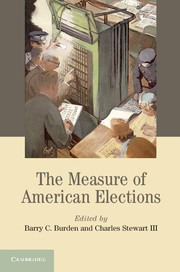Book contents
- Frontmatter
- Contents
- List of figures
- List of tables
- List of contributors
- Acknowledgments
- 1 Introduction to the Measure of American Elections
- 2 Registration and Voting: A View from the Top
- 3 Voter Registration: The Process and Quality of Lists
- 4 Provisional Ballots
- 5 Mail Ballots in the United States: Policy Choice and Administrative Challenges
- 6 Voting from Abroad: Evaluating UOCAVA Voting
- 7 Polling Place Practices and the Voting Experience
- 8 Disability and Election Policies and Practices
- 9 The Performance of Election Machines and the Decline of Residual Votes in the United States
- 10 Voter Confidence as a Metric of Election Performance
- 11 Election Data Transparency
- Appendix
- References
- Index
9 - The Performance of Election Machines and the Decline of Residual Votes in the United States
Published online by Cambridge University Press: 05 August 2014
- Frontmatter
- Contents
- List of figures
- List of tables
- List of contributors
- Acknowledgments
- 1 Introduction to the Measure of American Elections
- 2 Registration and Voting: A View from the Top
- 3 Voter Registration: The Process and Quality of Lists
- 4 Provisional Ballots
- 5 Mail Ballots in the United States: Policy Choice and Administrative Challenges
- 6 Voting from Abroad: Evaluating UOCAVA Voting
- 7 Polling Place Practices and the Voting Experience
- 8 Disability and Election Policies and Practices
- 9 The Performance of Election Machines and the Decline of Residual Votes in the United States
- 10 Voter Confidence as a Metric of Election Performance
- 11 Election Data Transparency
- Appendix
- References
- Index
Summary
One of the lessons the 2000 election taught Americans is that voting machines can sometimes interfere with the conduct of elections. The Florida recount revealed that machine malfunctions (symbolized by hanging chad) and poor ballot design (symbolized by the butterfly ballot) can throw up barriers to voters who wish nothing more than to cast a ballot in an election.
The problems that beset Florida in 2000 were dramatic and compelling. Yet, once the controversy had died down, the serious question remained: Was what happened in Florida specific to the Sunshine State, or was it part of a more general malady that infected voting technology nationwide? Given the vastness of the country and the heterogeneity of how Americans vote, was there a way to put the problems brought to light in Florida in a broader context, so that this question about its general applicability to the rest of the nation could be answered?
The desire to place Florida’s problems counting votes into a broader national context led to the development of a metric to assess the relative performance of voting machines, termed the residual vote rate. This metric can be applied to any voting machine in such a way that it is possible to compare different machines with each other, as well as different communities. The purpose of this chapter is to explore this measure in some detail, so that its use can be better understood.
- Type
- Chapter
- Information
- The Measure of American Elections , pp. 223 - 247Publisher: Cambridge University PressPrint publication year: 2014
- 2
- Cited by

